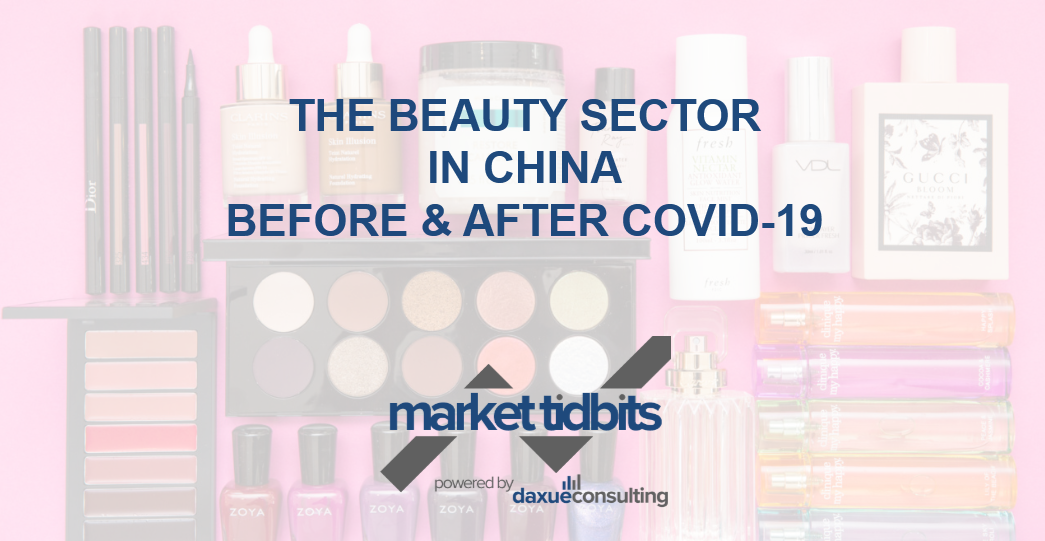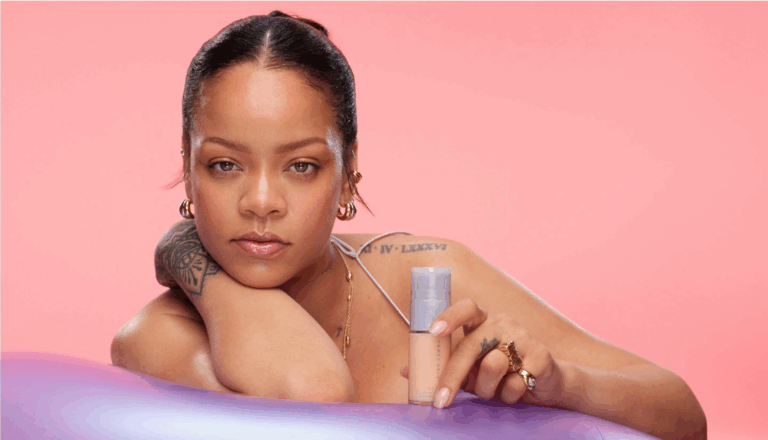Find the first Market Tidbits here.
Matthieu David: Hello everyone, today we are going to look into the beauty sector in China, and the report we published a few days ago, maybe two weeks ago about how Covid-19 impacted the beauty sector in China. How it impacted during the epidemic and after the epidemic. I’m here to talk about the report with Allison Malmsten who has worked on the report and we will like to share today with the audience a few conclusions we had on the report, especially Alison you mentioned, an overview of the beauty sector before Covid-19 and some of the trends which came out of this and which were a change in the sector. What kind of changes and differences did you see before Covid-19 and just after Covid-19 in China.
Allison Malmsten: Right, hi – so I am Allison, one of the marketing managers at Daxue Consulting. So, first, China’s beauty market is by no means small, it’s the second-largest in the world at over 300 billion renminbi in annual revenue. Skincare taken 54% of the beauty sector in China and some trends that we saw before Covid-19 were – 1] the high-end segment was growing proportionately faster, so high-end brand segment was growing at 18% year on year while the mass brands were only growing at 5% year on year. 2] Second is that social commerce is blossoming, this is Xiaohongshu and also WeChat has its own platform called 有赞 (youzan) and what we saw is on these platforms, especially for the beauty sector in China the conversion rate is pretty high, and so this is kind of a new way of shopping and the year on year growth for Xiaohongshu was double in 2019. Lastly, there’s a rising preference for a domestic brand. Looking at the top 20 beauty brands in China, in 2012 only 7.6% of them were Chinese while in 2018 14% of the top 20 beauty brands in China were domestic Chinese brands, so this growth is pretty significant.
Matthieu David: Very interesting, it seems that the Covid-19 accelerated some trends which were already happening before such as social commerce, Xiaohongshu being one example, that’s what existed before, and the epidemic was let’s say a time where people had more time to spend online and to do social commerce. Do you have the same analysis at the trend that is not necessarily new, whether they have been accelerated with Covid-19?
Allison Malmsten: Right so out of the three trends I mentioned, yes, the social commerce is definitely even more significant now because obviously during the pandemic people were less willing to go to offline stores and they were doing more live stream shopping and more shopping on Xiaohongshu and KOL marketing is definitely very important during this time. There is one trend that might take a turn and that is the high-end segment was growing very fast before and we might see the slowdown as people will be preferred – they’ll be looking more at ingredients and less at brand names, so this could give a chance to any brands that focus on natural ingredients and focus on skin health and skin repair.
Matthieu David: Very interesting to see indeed, in the report we mentioned that Chinese consumers online were looking at the ingredients and at the quality of the beauty product they were buying, more than before and I think within the report we found out that not all the categories went up and for instance make up went down if my memory is correct and specifically some beauty products and financing on natural ingredients grew faster.
Allison Malmsten: Yeah so, cosmetics were hit the hardest. A McKinsey survey showed that 44% of respondents purchased less make up, while 31% purchased less skincare but then also 25% of people purchased more skin care so it’s kind of balanced out but yeah and then within makeup, obviously lipstick pretty much because everybody is wearing a mask, so there’s a beauty style now called the ko [inaudible 05:00] its makeup for wearing masks, so the focus is really on the eyes and also the skin and so the skin care sector, it did take a bit of a hit but it’s also doing pretty okay and a lot of the focus when people are at home – our social listening showed that a lot of people are talking about its time to be at home and they’re wearing less makeup so they see that their skin is getting healthier so they’re very excited about those results and it inspires them to purchase more skincare products, while at the same time wearing a mask for a long time can be very damaging to the skin, so a lot of people are searching for products that have skincare repair functions and also skin sensitivity is a big keyword now. A lot of people are finding that they have sensitive skin and they’re looking for skincare products that can help repair their skin damage from wearing a mask including anything like natural ingredients are really popular right now.
Matthieu David: And some of the comments we found online through social listening were saying that people were switching from makeup to skincare instead of putting makeup to take more care about their skin with specific products, I would say more natural products. I’d like to go back on the Chinese brands – you mentioned that Chinese brands took off during the Covid-19 lockdown and after the Covid-19. Do you see here long-term trend or it’s just short term and was during the epidemic, or do you see a substantial change which is going to stay?
Allison Malmsten: I think that this is going to – the preference for domestic brands, I think this is going to be a long-term trend. I think this is a trend that was accelerated from Covid-19 and the reasons are 1] because patriotism is a very high right now in general, 2] because also domestic brands really understand Chinese consumers and they understand how to reach them. They’re usually very proactive about social commerce and also, they are familiar with like some Chinese herbal ingredients that are very in right now and so they include those in their ingredient list and yeah, I think that a lot of Chinese brands are gaining momentum right now.
Matthieu David: And we looked into a very specific brand called Perfect Diary in the past and it’s a very, very Chinese company which is doing very well. In a topic, we’d actually like to talk about which is product traffic and Perfect Diary has been an example of being very good at product traffic. Product traffic being something very specific to china where e-commerce started with marketplaces like Taobao and then Tmall and then JingDong and many other marketplaces where having your own website and selling through your own website was not mainstream and now its becoming more the case – not selling through your own website, but your website, your WeChat groups, your WeChat channels and your live streaming. So, using a marketing platform to convert on your own asset, your own digital asset, and not through a marketplace. What did you see in terms of digital changes during the pandemic and after?
Allison Malmsten: So, I saw some digital changes, one like you mentioned private traffic and then two is also live streaming. Live stream obviously ballooned under lockdown, while everybody was at home they spent more time on their phone and inevitably they spent a lot of time shopping on their phone or looking at products and so some statistic for that was that as of February 18th, the monthly number of live streaming events on Taobao ballooned by a 110% year on year. Also, Douyin, also experienced around 70 to 100% growth during the lockdown period, so a lot of brands are using live streaming now. And then also one case, in particular, is [inaudible 09:10] which is an Australian beauty brand, during the coronavirus they directed its offline stores to all sell on WeChat, so that is over a 1000 stores that would normally have offline sales, offline staff, they all went online during that period and they actually had sales of 6.3 million renminbi during a live stream event that happened during the coronavirus lockdown in china.
Matthieu David: I believe that the next step is to see those trends now continuing or if it was just a short-term trend during and after the pandemic.
Allison Malmsten: Right, yes that will be very interesting to see because once stores open up, I’m sure people are very eager to go out shopping again but at the same time they might be a little bit more cautious to hit the stores.
Matthieu David: Thank you, everyone, for listening and we will continue with new reports, we will go through together online.
Find the full beauty sector in China Report





